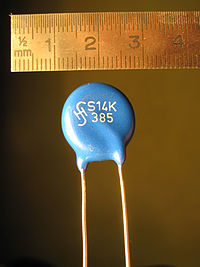
Photo from wikipedia
The transient performance of power semiconductor devices relates directly to their available power rating, reliability, and operating lifetime. This paper examines the transient thermal performance of liquid-cooled, silicon carbide power… Click to show full abstract
The transient performance of power semiconductor devices relates directly to their available power rating, reliability, and operating lifetime. This paper examines the transient thermal performance of liquid-cooled, silicon carbide power devices subjected to different unsteady electrical loads. The first part uses infrared thermography to examine an observed asymmetrical device thermal time constant when subjected to step-change increases and decreases in current. A theoretical analysis connects this behavior to the dependence of mosfet on-resistance on junction temperature. It also identifies three time constants that characterize junction transient response, one each for the die, the module, and the cold plate. The second part extends the transient thermal evaluation to half-sine wave periodic excitations that emulate real-application operating conditions. These experiments show that thermal ripple increases with increasing excitation amplitude but decreases with increasing excitation frequency. They also connect the observed thermal response to the time constants inferred from the step-change experiments. Both parts of the study show the importance of considering transient loads when designing power electronics cooling systems and the role that electrical properties play in determining unsteady thermal response.
Journal Title: IEEE Transactions on Power Electronics
Year Published: 2018
Link to full text (if available)
Share on Social Media: Sign Up to like & get
recommendations!